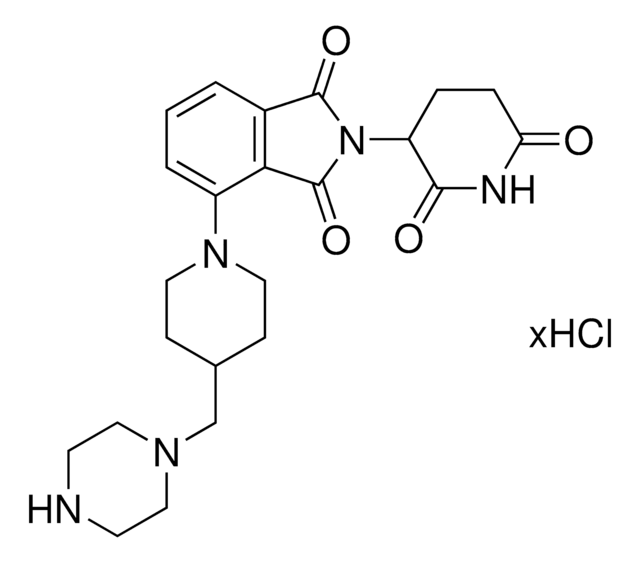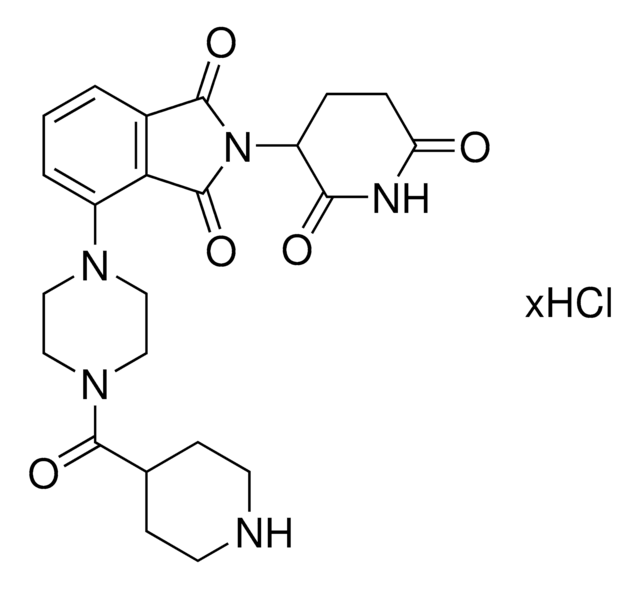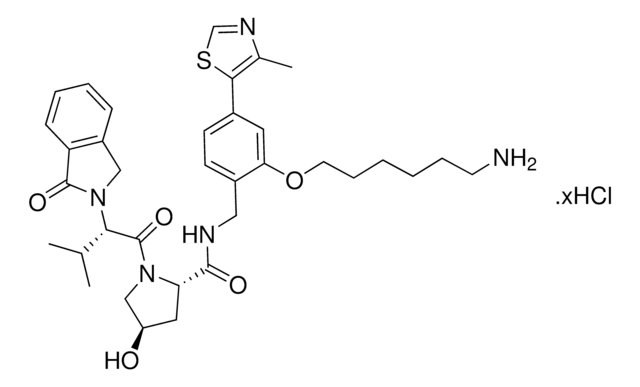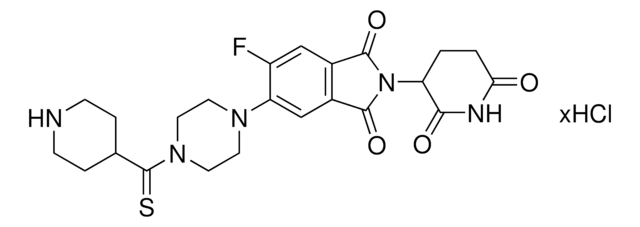Kluczowe dokumenty
922161
(S,R,S)-VL285 Phenol-methylamino-PEG1-NH2 hydrochloride
Synonim(y):
(2S,4R)-N-{[2-(2-{[2-(2-aminoethoxy)ethyl](methyl)amino}ethoxy)-4-(4-methyl-1,3-thiazol-5-yl)phenyl]methyl}-4-hydroxy-1-[(2S)-3-methyl-2-(1-oxo-2,3-dihydro-1H-isoindol-2-yl)butanoyl]pyrrolidine-2-carboxamide, Koniugat ligandu Crosslinker-E3 Ligase, Moduł degradujący białko VHL dla badań 11779
About This Item
Polecane produkty
ligand
VL285 phenol
Poziom jakości
Formularz
solid
przydatność reakcji
reactivity: carboxyl reactive
reagent type: ligand-linker conjugate
grupa funkcyjna
amine
temp. przechowywania
2-8°C
ciąg SMILES
O=C([C@@H]1C[C@@H](O)CN1C([C@H](C(C)C)N2CC(C=CC=C3)=C3C2=O)=O)NCC4=CC=C(C5=C(C)N=CS5)C=C4OCCN(C)CCOCCN.Cl
InChI
1S/C36H48N6O6S.ClH/c1-23(2)32(42-20-27-7-5-6-8-29(27)35(42)45)36(46)41-21-28(43)18-30(41)34(44)38-19-26-10-9-25(33-24(3)39-22-49-33)17-31(26)48-16-13-40(4)12-15-47-14-11-37;/h5-10,17,22-23,28,30,32,43H,11-16,18-21,37H2,1-4H3,(H,38,44);1H/t28-,30+,32+;/m1.
Klucz InChI
VVMBTXRZOCAUEV-TUBUYWNKSA-N
Powiązane kategorie
Zastosowanie
Inne uwagi
Portal: Building 11779 Degraders for Targeted Protein Degradation
Targeted Protein Degradation by Small Molecules
Targeted Protein Degradation: from Chemical Biology to Drug Discovery
HaloPROTACS: Wykorzystanie małocząsteczkowych PROTAC do indukcji degradacji białek fuzyjnych HaloTag
Różna specyficzność substratowa PROTAC podyktowana orientacją rekrutowanej ligazy E3
Informacje prawne
produkt powiązany
Kod klasy składowania
11 - Combustible Solids
Klasa zagrożenia wodnego (WGK)
WGK 3
Temperatura zapłonu (°F)
Not applicable
Temperatura zapłonu (°C)
Not applicable
Wybierz jedną z najnowszych wersji:
Certyfikaty analizy (CoA)
It looks like we've run into a problem, but you can still download Certificates of Analysis from our Dokumenty section.
Proszę o kontakt, jeśli potrzebna jest pomoc Obsługa Klienta
Masz już ten produkt?
Dokumenty związane z niedawno zakupionymi produktami zostały zamieszczone w Bibliotece dokumentów.
Global Trade Item Number
| SKU | GTIN |
|---|---|
| 922161-50MG | 4065266768022 |
Nasz zespół naukowców ma doświadczenie we wszystkich obszarach badań, w tym w naukach przyrodniczych, materiałoznawstwie, syntezie chemicznej, chromatografii, analityce i wielu innych dziedzinach.
Skontaktuj się z zespołem ds. pomocy technicznej








